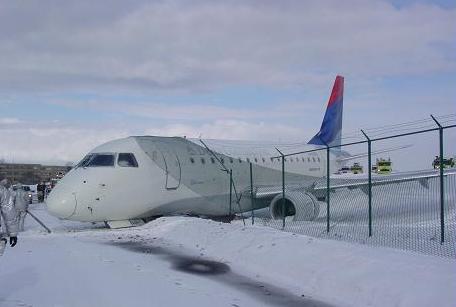The US FAA is alerting airlines to retool procedures and training in several areas linked to landings in bad weather. In two safety alerts for operators (SAFOs) issued yesterday, the agency recommended additional simulator training and upgraded standard operating procedures to combat runway overrun accidents.
As a result of the 18 February 2007 overrun in which a Shuttle America Embraer ERJ170 departed the runway at the Cleveland Hopkins International Airport, the agency is requesting that operators introduce rejected landing scenarios during simulator training sessions, including performing a rejected landing below 100ft (30.4m) of altitude. In the Shuttle America accidents, pilots lost visual contact with the runway at low altitude during the landing due to a snow squall. The aircraft overran the runway end and suffered a collapsed nose-gear as it struck an instrument landing system (ILS) antenna and the airport's perimeter fence.
 |
|---|
©NTSB |
The US NTSB had requested that the FAA require airlines to train pilots to perform rejected landings below 50ft.
The second SAFO comes as the result of two runway overrun accidents where flight crews "did not fully utilize the braking capabilities available to them on the contaminated runway", says the FAA.
To help avoid the situation, the agency is recommending that airlines update their standard operating procedures (SOPs) for pilots to include criteria for stabilized approaches that end with a landing in the touchdown zone as well as "the proper application of aircraft landing performance data, the proper deployment of aircraft deceleration devices, and the proper braking concept".
In addition to specifying the minimum altitudes for having the aircraft stabilized on the approach, the FAA says the SOPs should also emphasize that pilots should perform a go-around rather than attempt a landing from an unstabilized approach.
Source: Air Transport Intelligence news
















